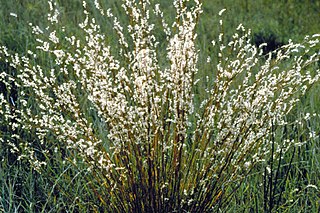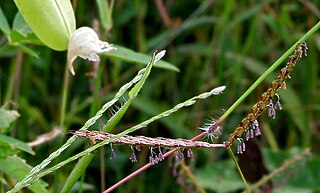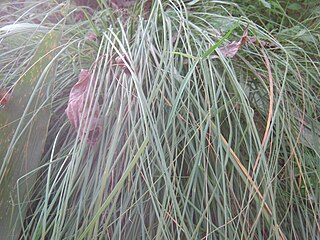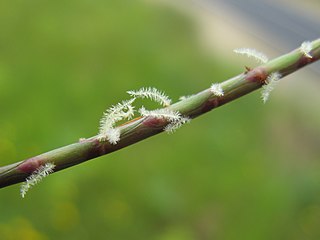
Cymbopogon, also known as lemongrass, barbed wire grass, silky heads, oily heads, Cochin grass, Malabar grass, citronella grass or fever grass, is a genus of Asian, African, Australian, and tropical island plants in the grass family. Some species are commonly cultivated as culinary and medicinal herbs because of their scent, resembling that of lemons . The name cymbopogon derives from the Greek words kymbe and pogon "which mean [that] in most species, the hairy spikelets project from boat-shaped spathes." Lemongrass and its oil are believed to possess therapeutic properties.

Polytrias is a genus of Asian, African, and Pacific Island plants in the grass family, commonly called Java grass, Batiki bluegrass, Indian murainagrass, or toto grass. The only known species is Polytrias indica, native to West Africa, Seychelles, the Indian Subcontinent, southern China, Southeast Asia, New Guinea, Fiji, and Micronesia. It is also cultivated as a lawn grass in other tropical regions, and naturalized in scattered locations in tropical North and South America.

The Andropogoneae, sometimes called the sorghum tribe, are a large tribe of grasses (family Poaceae) with roughly 1,200 species in 90 genera, mainly distributed in tropical and subtropical areas. They include such important crops as maize (corn), sugarcane, and sorghum. All species in this tribe use C4 carbon fixation, which makes them competitive under warm, high-light conditions.

Bothriochloa is a common and widespread genus of plants in the grass family native to many countries on all inhabited continents and many islands. They are often called beardgrass, bluegrass or bluestem. Some species are invasive in areas where they have been introduced.

Ischaemum is a genus in the tribe Andropogoneae, belonging to the grass family, widespread in tropical and semitropical regions in many countries. Many species are known commonly as murainagrass.

Themeda is a genus of plants in the grass family native to Asia, Africa, Australia, and Papuasia. There are about 18 to 26 species, many of which are native to Southeast Asia.

Eulaliopsis is a genus of Asian plants in the grass family.
Pogonachne is a genus of Indian plants in the grass family. The only known species is Pogonachne racemosa, native to Maharashtra.
Pseudodanthonia is a genus of Himalayan plants in the grass family. The only known species is Pseudodanthonia himalaica, native to Uttarakhand and Uttar Pradesh in northern India
Apocopis is a genus of Asian plants in the grass family, widespread in China, the Indian Subcontinent, and Southeast Asia, including several species endemic to Myanmar (Burma).
Castellia is a genus of African and Eurasian plants in the grass family. The only known species is Castellia tuberculosa, native to southern Europe, northern and northeastern Africa, and southwestern Asia.
Lophopogon is a ditypic genus endemic to India, consisting of two well-known species Lophopogon tridentatus (Roxb.) Hackel and Lophopogon kingii Hook f. belonging to the tribe Andropogoneae in the grass family.
Dichaetaria is a genus of South Asian plants in the grass family.
Oropetium is a genus of Asian and African plants in the grass family.

Eragrostiella is a genus of Asian, African, and Australian plants in the grass family.

Hemarthria is a genus of herbaceous plants in the grass family. They occur in the tropical and subtropical Old World, especially in China and Southeast Asia, with some species in Africa, Australia, and Southern Europe. They may be known generally as jointgrasses.
Hemisorghum is a genus of Asian plants in the grass family.
Hubbardia is a genus in the grass family that is endemic to India. It is the only genus in the tribe Hubbardieae of the subfamily Micrairoideae.
Indopoa is a genus of Indian plants in the grass family. The only known species is Indopoa paupercula, native to Maharashtra and Karnataka in India.

Jansenella is a genus of Asian plants in the grass family.










